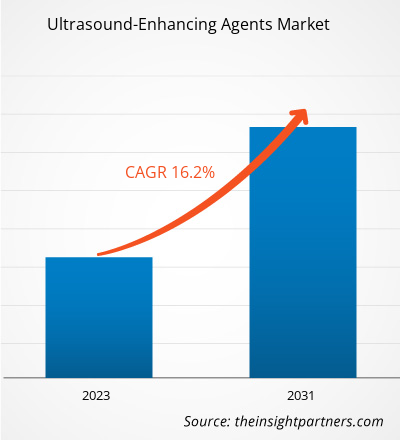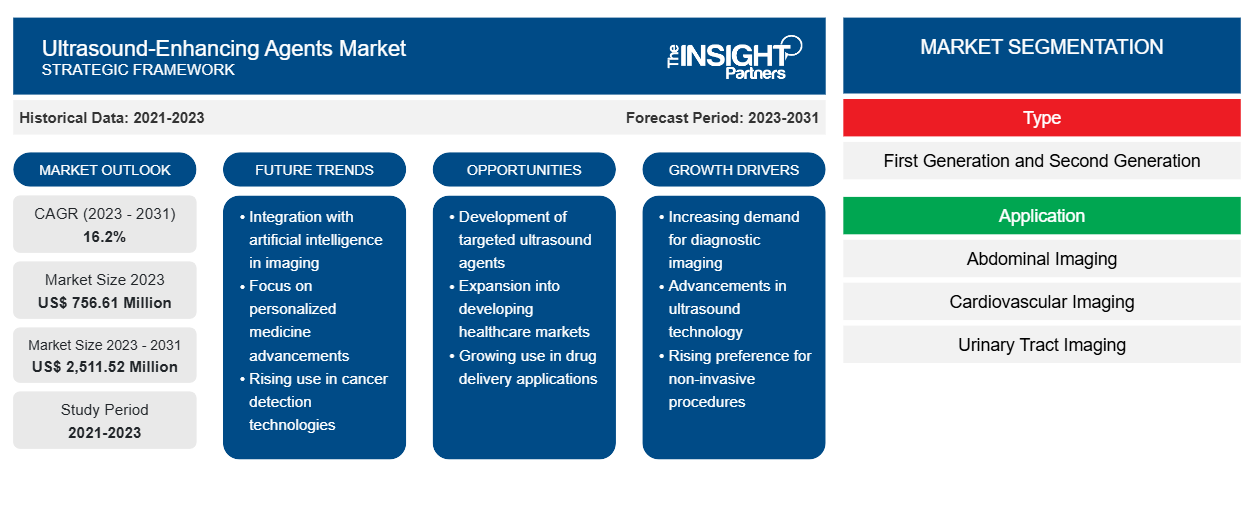La previsione del mercato degli agenti di potenziamento degli ultrasuoni è derivata sulla base di risultati provenienti da varie fonti di ricerca secondarie e primarie. Secondo le stime di The Insight Partners, il mercato è stato valutato a 756,61 milioni di dollari USA nel 2023 e si prevede che raggiungerà 2.511,52 milioni di dollari USA entro il 2031; si stima che registrerà un CAGR del 16,2% nel periodo 2023-2031.
Gli agenti che migliorano gli ultrasuoni, noti anche come agenti di contrasto per ultrasuoni (UCA), vengono iniettati per migliorare la risoluzione delle immagini degli organi durante un'ecografia. Questi agenti sono costituiti da sospensioni di microbolle piene di gas più piccole dei globuli rossi e riflettono i segnali ultrasonici mentre scorrono attraverso la microcircolazione nei vasi sanguigni. Vengono espulsi dal corpo tramite urina o movimenti intestinali, entro pochi minuti dall'iniezione. Questi agenti non contengono coloranti e sono considerati sicuri in quanto non presentano alcun rischio noto di nefrotossicità.
Fattori che guidano la crescita del mercato degli agenti di miglioramento degli ultrasuoni
L'imaging ecografico è attualmente il primo passo nella stima della gravità delle malattie oncologiche e delle condizioni cardiovascolari, aprendo la strada a una valutazione e diagnosi accurate attraverso ulteriori indagini. È ampiamente utilizzato per l'imaging in tempo reale di parti del corpo per il rilevamento di anomalie grazie alla portabilità, al basso costo, alla sicurezza e alle capacità diagnostiche del sistema. Inoltre, l'uso di agenti di contrasto ha migliorato significativamente la sensibilità e la specificità dell'ecografia per il rilevamento di stadi iniziali delle malattie, aprendo così nuove possibilità per la ricerca cellulare e molecolare in questo campo. La crescente prevalenza di malattie croniche come cancro, malattie renali e disturbi epatici spinge la domanda di diagnosi precoci per una migliore gestione. Le loro diagnosi necessitano di modalità di imaging avanzate per la diagnosi precoce e il monitoraggio della salute tra i pazienti diagnosticati. Gli agenti di miglioramento degli ultrasuoni consentono una visualizzazione migliorata di tumori, lesioni e crescita anomala dei tessuti. Secondo un articolo pubblicato su radiopaedia.org nel settembre 2023, Sonazoid, un agente di contrasto utilizzato nell'imaging ecografico, migliora il contrasto del fegato nella fase postvascolare, il che può aiutare a rilevare tumori epatici, in particolare quelli senza metastasi delle cellule di Kupffer. Sonazoid aiuta anche a distinguere tra noduli rigenerativi e displastici dai carcinomi epatocellulari in fase iniziale in un fegato cirrotico. Pertanto, la crescente adozione di UCA nell'imaging diagnostico aumenta le dimensioni del mercato degli agenti di miglioramento degli ultrasuoni .
Secondo un articolo pubblicato nell'ottobre 2021 dall'International Contrast Ultrasound Society (ICUS), 57 studi di ricerca originali si sono concentrati esclusivamente su pazienti pediatrici, tra cui 4.518 bambini sottoposti a 4.906 esami ecografici con mezzo di contrasto per via endovenosa ad agosto 2021. Inoltre, protocolli completi sviluppati per valutare la sicurezza clinica hanno dimostrato il profilo di sicurezza altamente favorevole degli UCA quando utilizzati per via endovenosa, intravescicale e tramite altre procedure intracavitarie.
Personalizza questo report in base alle tue esigenze
Riceverai la personalizzazione gratuita di qualsiasi report, comprese parti di questo report, o analisi a livello nazionale, pacchetto dati Excel, oltre a usufruire di grandi offerte e sconti per start-up e università
-
Scopri le principali tendenze di mercato in questo rapporto.Questo campione GRATUITO includerà analisi di dati che spaziano dalle tendenze di mercato alle stime e alle previsioni.
Segmentazione e ambito del report:
"Global Ultrasound-Enhancing Agents Market Analysis to 2031" è uno studio specializzato e approfondito incentrato sulle dinamiche del mercato globale per aiutare a identificare i principali fattori trainanti, le tendenze future e le opportunità redditizie che, a loro volta, aiuterebbero a identificare le principali sacche di fatturato. Il rapporto mira a fornire una panoramica del mercato con una segmentazione dettagliata del mercato per tipo, applicazione e utente finale. L'ambito geografico del rapporto di mercato sugli agenti di miglioramento degli ultrasuoni comprende Nord America (Stati Uniti, Canada e Messico), Europa (Spagna, Regno Unito, Germania, Francia, Italia e resto d'Europa), Asia Pacifico (Corea del Sud, Cina, India, Giappone, Australia e resto dell'Asia Pacifico), Medio Oriente e Africa (Sudafrica, Arabia Saudita, Emirati Arabi Uniti e resto del Medio Oriente e Africa) e Sud e Centro America (Brasile, Argentina e resto del Sud e Centro America).
Analisi segmentale:
Il mercato degli agenti di potenziamento degli ultrasuoni, per tipo, è diviso in prima e seconda generazione. Il segmento di seconda generazione ha detenuto una quota di mercato maggiore nel 2023. Si prevede che registrerà un CAGR più elevato dal 2023 al 2031.
Il mercato, per applicazione, è segmentato in imaging addominale, imaging cardiovascolare, imaging del tratto urinario e altri. Il segmento dell'imaging addominale ha rappresentato la quota di mercato più grande degli agenti di miglioramento degli ultrasuoni nel 2023. Si prevede che il segmento dell'imaging cardiovascolare registrerà il CAGR più elevato dal 2023 al 2031.
In base all'utente finale, il mercato è segmentato in ospedali, centri di diagnostica e imaging e altri. Il segmento degli ospedali ha detenuto la quota maggiore del mercato nel 2023. Inoltre, si prevede che il segmento dei centri di diagnostica e imaging registrerà il CAGR più elevato dal 2023 al 2031.
Prospettive regionali:
Il Nord America ha detenuto la quota di mercato più grande degli agenti di miglioramento degli ultrasuoni nel 2023. Gli Stati Uniti hanno dominato il mercato in questa regione, in termini di quota, seguiti dal Canada. La crescita del mercato negli Stati Uniti è attribuita a fattori come la presenza di importanti attori, tra cui Lantheus Holdings Inc. e GE Healthcare. Queste aziende si stanno concentrando sempre di più su joint venture e collaborazioni di ricerca. Ad esempio, GE Healthcare si concentra sull'espansione del suo portafoglio prodotti lanciando prodotti innovativi e stringendo partnership strategiche con i concorrenti. Inoltre, un aumento del numero di procedure ecografiche dovuto a politiche di rimborso favorevoli supporta la crescita del mercato degli agenti di miglioramento degli ultrasuoni negli Stati Uniti.
Sviluppi del settore e opportunità future:
Secondo i comunicati stampa aziendali, di seguito sono elencate alcune iniziative intraprese dai principali attori che operano nel mercato globale degli agenti che migliorano gli ultrasuoni:
- A marzo 2024, Samsung Medison e Bracco Imaging hanno sottoscritto un accordo di Memorandum of Understanding (MoU) per sviluppare una nuova area per dispositivi diagnostici a ultrasuoni e mezzi di contrasto al Congresso europeo di radiologia (ECR) 2024, tenutosi dal 28 febbraio al 3 marzo a Vienna, Austria. Due aziende stanno valutando di collaborare per sviluppare protocolli di imaging ad alta frequenza e super risoluzione per la diagnosi. La collaborazione includerebbe anche attività di marketing, formazione degli operatori sanitari ed esplorazione di tecnologie di somministrazione di farmaci con contrasto mirate agli ultrasuoni con agenti farmaceutici.
- Ad aprile 2023, GE HealthCare ha lanciato Pixxoscan (Gadobutrol). Si tratta di un agente di contrasto macrociclico a base di gadolinio (GBCA) per la risonanza magnetica non ionica . Il prodotto è stato aggiunto al portafoglio di mezzi di contrasto per MRI dell'azienda, che include Claiscan (acido gadoterico macrociclico) e Rapiscan (utilizzato nella risonanza magnetica cardiaca da stress per aiutare la diagnosi della malattia coronarica).
Informazioni regionali sul mercato degli agenti di miglioramento degli ultrasuoni
Le tendenze regionali e i fattori che influenzano il mercato degli agenti di potenziamento degli ultrasuoni durante il periodo di previsione sono stati ampiamente spiegati dagli analisti di Insight Partners. Questa sezione discute anche i segmenti e la geografia del mercato degli agenti di potenziamento degli ultrasuoni in Nord America, Europa, Asia Pacifico, Medio Oriente e Africa e America meridionale e centrale.

- Ottieni i dati specifici regionali per il mercato degli agenti di miglioramento degli ultrasuoni
Ambito del rapporto di mercato sugli agenti di miglioramento degli ultrasuoni
| Attributo del report | Dettagli |
|---|---|
| Dimensioni del mercato nel 2023 | 756,61 milioni di dollari USA |
| Dimensioni del mercato entro il 2031 | 2.511,52 milioni di dollari USA |
| CAGR globale (2023-2031) | 16,2% |
| Dati storici | 2021-2023 |
| Periodo di previsione | 2023-2031 |
| Segmenti coperti |
Per tipo
|
| Regioni e Paesi coperti |
America del Nord
|
| Leader di mercato e profili aziendali chiave |
|
Agenti di miglioramento degli ultrasuoni: densità degli attori del mercato: comprendere il suo impatto sulle dinamiche aziendali
Il mercato degli agenti di potenziamento degli ultrasuoni sta crescendo rapidamente, spinto dalla crescente domanda degli utenti finali dovuta a fattori quali l'evoluzione delle preferenze dei consumatori, i progressi tecnologici e una maggiore consapevolezza dei benefici del prodotto. Con l'aumento della domanda, le aziende stanno ampliando le loro offerte, innovando per soddisfare le esigenze dei consumatori e capitalizzando sulle tendenze emergenti, il che alimenta ulteriormente la crescita del mercato.
La densità degli operatori di mercato si riferisce alla distribuzione di aziende o società che operano in un particolare mercato o settore. Indica quanti concorrenti (operatori di mercato) sono presenti in un dato spazio di mercato in relazione alle sue dimensioni o al valore di mercato totale.
Le principali aziende che operano nel mercato degli agenti che migliorano gli ultrasuoni sono:
- Società a responsabilità limitata Lantheus Holdings Inc.
- Assistenza sanitaria GE
- Solstice Pharmaceuticals BV
- FUJIFILM VisualSonics, Inc.
- Bracco Diagnostics Inc.
Disclaimer : le aziende elencate sopra non sono classificate secondo un ordine particolare.

- Ottieni una panoramica dei principali attori del mercato degli agenti di miglioramento degli ultrasuoni
Scenario competitivo e aziende chiave:
Lantheus Holdings Inc.; GE Healthcare; Solstice Pharmaceuticals BV; FUJIFILM VisualSonics, Inc.; Bracco Diagnostics Inc.; Bayer AG; e Vesselon sono tra le aziende di spicco descritte inil rapporto di mercato degli agenti di potenziamento degli ultrasuoni. Queste aziende si concentrano su nuove tecnologie, progressi di prodotti esistenti ed espansioni geografiche per soddisfare la crescente domanda dei consumatori in tutto il mondo.
- Analisi storica (2 anni), anno base, previsione (7 anni) con CAGR
- Analisi PEST e SWOT
- Valore/volume delle dimensioni del mercato - Globale, Regionale, Nazionale
- Industria e panorama competitivo
- Set di dati Excel
Report recenti
Testimonianze
Motivo dell'acquisto
- Processo decisionale informato
- Comprensione delle dinamiche di mercato
- Analisi competitiva
- Analisi dei clienti
- Previsioni di mercato
- Mitigazione del rischio
- Pianificazione strategica
- Giustificazione degli investimenti
- Identificazione dei mercati emergenti
- Miglioramento delle strategie di marketing
- Aumento dell'efficienza operativa
- Allineamento alle tendenze normative























 Ottieni un campione gratuito per - Mercato degli agenti che migliorano gli ultrasuoni
Ottieni un campione gratuito per - Mercato degli agenti che migliorano gli ultrasuoni